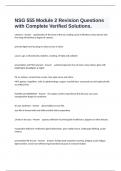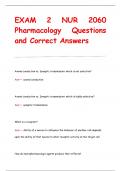NSG 555 Module 2 Revision Questions
with Complete Verified Solutions.
cataracts - Answer opacification of the lense of the eye. leading cause of blindness. Every person who
lives long will develop a degree of cataract.
prevents light from focusing on retina so loss of vision
causes: age, corticosteroids, diabetes, smoking, UV light and radiation
presentation and PEof cataracts - Answer -painful progressive loss of vision, hazy, haloes, glare with
bright lights (headlights @ night)
PE: no redness, corneal haze or pain. hazy optic nerve and retina.
MGT: glasses, magnifiers, refer to ophthamology. surgery: emulsift lens, vacuumed out and replaced with
an artificial lens
FLOMAX and CATARACTS - Answer No surgery, need to stop flomax first because can cause
intraoperative floppy iris syndrome
dry eye syndrome - Answer abnormalities in tear film.
tear film is formed with each blink and this limits evaporation.
2 kinds of dry eyes - Answer aqueous-deficient--lacrimal gland insufficiency. Sjogrens or other disease
evaoprative deficient--meibomian gland dysfunction, poor eyelid closure, inadequate blinking, ocular
rosacea
presentation/PE dry eye - Answer dryness, foreign body sensation, burning, stinging, ocular fatigue,
light sensitive. some have reflexive hypersecretion because of corneal irritation
,meds causing dry eyes: anticholinergic, alpha blocker (flomax), anti HTN, oral corticosteroids, vitamins,
autoimmune disease
Assess: visual acuity, fluorescein dye , cranial nerve function
diagnostics of dry eye - Answer schirmer test (filter paper to measure tear production)
pharm treatment dry eye - Answer artificial tears, ointments, preservative free if needed
--cyclosporin (restasis) or xiidra for long term treatment of dry eye
--doxycycline for aqueaous-deficient dry eye d/t rosacea or meibomian gland dysfunction.
--therapeutic contact lenses to improve tear retnetion
indications for referral/hospitalization: dry eye - Answer visual loss, severe pain, corneal ulceration`
nasal tumors and polyps--most common - Answer inverted papilloma between nose and maxillary
sinus
Highly vascular benign tumor
Common in boys of adolescent age
nasal polyps - Answer inflammatory disorder of nose and paranasal sinuses that can result in chronic
nasal obstruction and a diminished sense of smell
common in 1/3 of patients/children with CF
pathophys of nasopharynx tumors - Answer dx difficult because varied pathophys.
more common in men, assoc. with smoking, etoh, sunlight exposure
clinical presentation/PE of nasal tumors - Answer mimic rhinitis or sinusitis
, unilateral nasal obstruction + pain, hemorrhage, HA, visual/olfactory changes
nasal obstruction, d/c, facial swelling, recurrent epistaxis (these are usually benign and can be seen)
nasal polyps presentation and PE - Answer nasal obstruction, hyposmia/anosmia, recurrent sinusitis,
HA, post-nasal drip, intrinsic asthma . teardrop or grap shaped.
use pen light to look at nares, assess lymph nodes,
diagnostics nasal polyps - Answer endoscopic eval and biopsy is gold standard
CBC
sinus x-ray, may need CT/MRI to assess bone involvement
priority differential dx for nasal tumors/polyps - Answer benign/malignant polyps, granulomatosis with
polyangiitis (wegeners), mucoceles, granulomas without systemic improvement
wegeners granulomatosis: systemic vasculitis by glomerulonephritis+granulomas of nose and lungs.
destruction of bone, cartilage, soft tissue of nose found on biopsy to be malignant neoplasms. Often first
s/s is resp. tract symptoms
pharm management of nasal polyps - Answer glucocorticoids: nasal topical, if not helpful then use
short course of oral corticosteroids
antihistamines may help s/s but not polyps themselves
CAM: intranasal capsaicin may help reduce size of polyp
surgery, they frequently return





